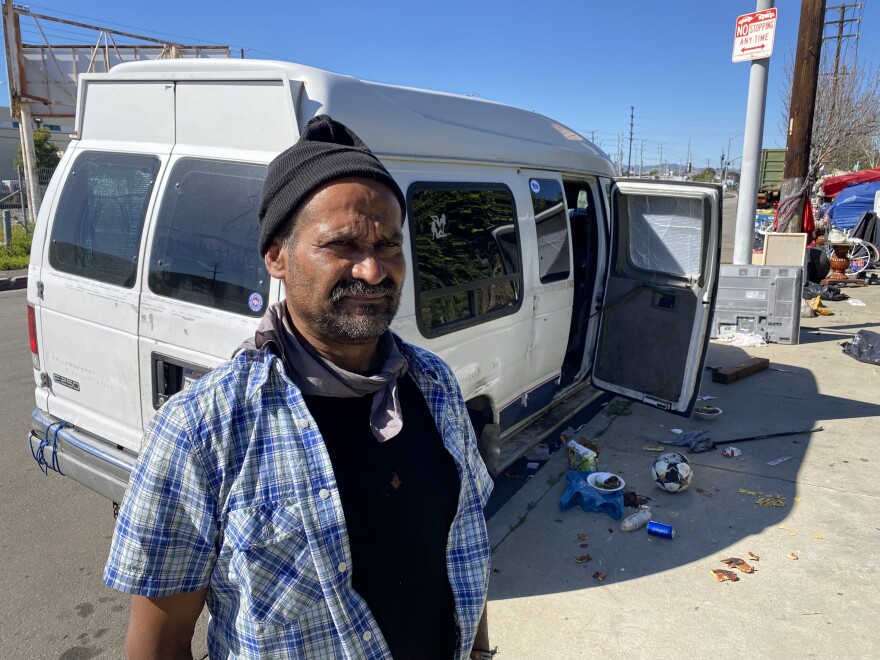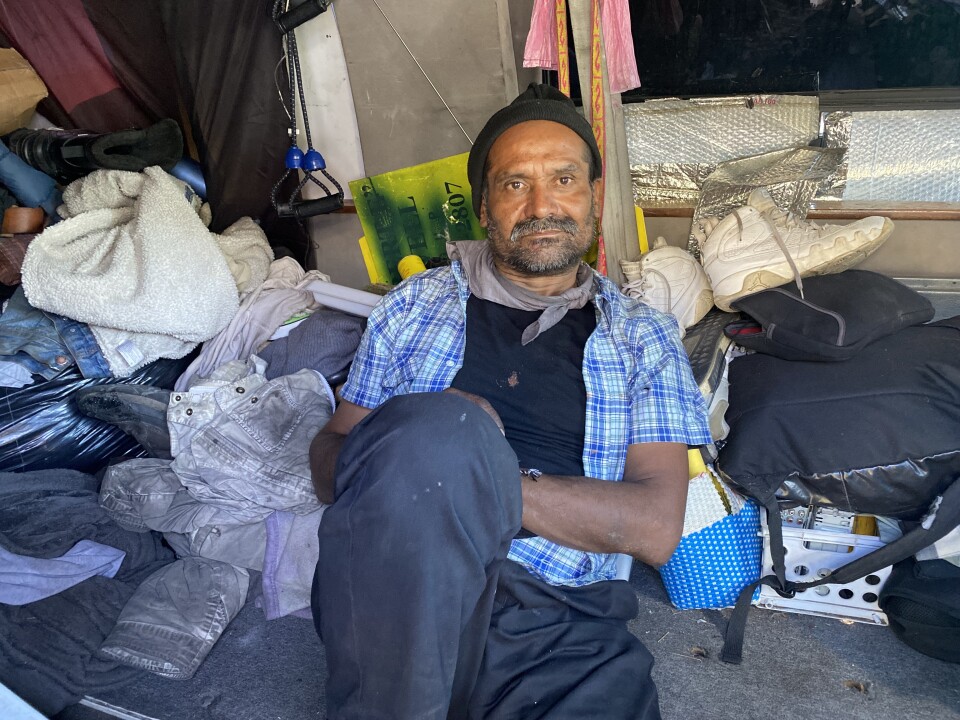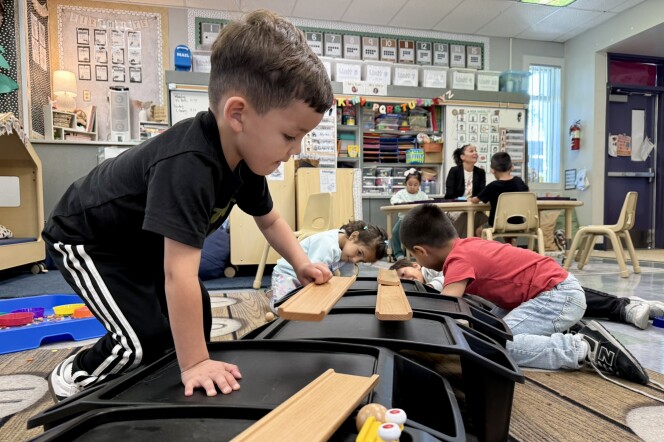With our free press under threat and federal funding for public media gone, your support matters more than ever. Help keep the LAist newsroom strong, become a monthly member or increase your support today.
People Living In RVs And Vans A Big Issue In Special Election To Replace Nury Martinez

Los Angeles City Council District 6 stretches nearly 20 miles across the San Fernando Valley floor, from Sun Valley west through Van Nuys to Lake Balboa. It crosses three freeways: the 5, the 170, and the 405.
About our coverage of the CD6 election
We've asked District 6 residents to describe their top concerns about their neighborhoods. What we've heard so far has helped shaped coverage of this special election, including this story. We first solicited those responses in a survey that went live in February and have followed up with a listening session.
We'd still like to hear from CD6 residents: Take the survey
Large clusters of parked vans and RVs dot the district, forming homeless camps that are among the top concerns for voters in the special election now underway to replace former City Councilmember Nury Martinez.
“I just want the next person in office to get rid of the RVs,” Sara Steffan says.
The JPL cybersecurity engineer jumps into her small SUV parked outside her home in the Chisholm Estates neighborhood of Van Nuys and drives me a few blocks to the Vanowen Street underpass of the 405.
She points out an RV with a stack of bicycles piled on the roof and on a trailer behind it.
“I can’t help but think, 'What if my bike is there?'” she says, noting that hers was recently stolen.
Steffan, 31, and her wife would like to walk this route to nearby stores but they’d have to pass at least a dozen RVs, vans, and cars parked along a stretch of Haskell Avenue.
“I would love to go this way, but unfortunately I don’t really feel safe,” she says.

More than 500 live in RVs and vans
Seven candidates are on the ballot in the race to replace Martinez in the April 4 special election. There are also four write-in candidates. Martinez resigned last October after she was heard on a secret audio recording making racist and homophobic remarks.
Every voter in the district already has received a mail-in ballot. Early in-person voting is also underway. If no candidate gets a majority of the votes, the top two finishers will head to a June runoff.
District 6 has about 3,200 unhoused people — the most in the San Fernando Valley. More than 500 live in more than 400 vans and RVs, according to the latest count from the L.A. Homeless Services Authority.
A tiny homes village opens
One effort to move people into housing is the tiny homes village, which provides transitional housing. The 11th such project in the city, dubbed Branford Village, just opened in Sun Valley.

At the ribbon cutting, Alexis Wesson, Martinez’ former chief of staff, acknowledges that “we do have a large number of RVs in this area, because it's an industrial zone.” Wesson continues to run the District 6 office in this interim period.
Branford Village can house 161 people in shelters that measure 64 square feet. Staff provides food and showers, along with mental health and drug counseling services.
People can stay 90 days, according to Charles Cleave II of Volunteers of America, which operates the project. They can stay longer if there is no permanent housing available for them.
“We’re not just going to kick them out,” he says.
The project sits on an old homeless camp next to railroad tracks. Cleave is interrupted as a train passes by and blows its horn.
“It’s definitely going to be a challenge,” he says of the noise. Cleave says crews added padding to the homes to mitigate it.
‘They have a door’
One of the tiny homes’ big attractions is that “they have a door,” says Desiree Martin, also with Volunteers of America. She says she’s seen people “just react to having a door and feeling that sense of safety.”

But people who live in their vehicles already have a door. Take the case of Quentin Rodriguez. I chatted with him in the white camper van he lives in. He’s parked outside a recycling plant on San Fernando Road, less than a block away from Branford Village.
Rodriguez, 54, works as a tree trimmer.
“I can still go up the trees like a boy,” he says. “I know everything about trees.” He’s seated on the floor of the van with some of his belongings scattered around him: an old pair of white high tops, a faded blue jean jacket, green rubber exercise bands.
Outreach workers from Branford Village visited Rodriguez recently. He says he’s intrigued by the idea.
“I don’t want to live in the streets like this,” he says. A tiny home “is better than here. Here we don’t have nothing: no shower, no bathroom.”
Rodriguez, whose smile reveals several lost teeth, confesses to a meth addiction.
“The drugs are my problem,” he says. “It's why I am here.”

But then Rodriguez thinks about it some more, and says he prefers to stay in his van, which still runs.
“No casa is better for me,” he says. “I don’t have to pay that much money,” referring to the area’s high rents. “It’s the way I live for a long time.”
‘The biggest nut we haven’t cracked is the RVs’
Mercedes Marquez, Mayor Karen Bass’ chief of housing and homelessness, acknowledges that it’s harder to convince people in camper vans and RVs to move into temporary housing.
“A lot of folks who live in RVs don’t consider themselves to be unhoused,” she says. “It is a different type of outreach that needs to be done to help them feel comfortable moving to another closed space.”
Especially when there is no guarantee of moving into something more permanent, given the paucity of the city’s affordable housing stock.
“The biggest nut we haven’t cracked is the RVs,” says Bass. She says another complication is that a lot of people rent the RVs they’re living in.
L.A. once had an ordinance that banned people from living in their RVs and camper vans on residential streets, but that law expired in January 2020.
The City Council approved a motion earlier this month asking city staff to examine ways to address the issue, including creating incentives for people to give up their RVs and expanding safe parking programs.
“I’d like to see the council move forward [and] tackle the RV situation,” Wesson says.
But Wesson is not a member of the council. This disenfranchisement of residents is part of the fallout of her old boss’ scandal.
“It can be challenging for sure when you don’t have a voting member in the seat,” she says.
The special election will change that.
Steffan will be closely watching who is elected — and what they do about camper vans and RVs.
“Building my trust in city government will definitely come from this special election,” Steffan says. “It will show me the direction that the valley is headed.”
Want to Help the Unhoused in the San Fernando Valley?
Here are several groups that are looking for volunteers:








